Flora and Fauna of the Pacific Northwest Coast
Last Updated on November 21, 2022 by

by Colin Varner
ISBN 978-0-295-74464-3
University of Washington Press, Seattle, Washington, 2018
Colin Varner started his career in 1977 in the botanical garden of the University of British Columbia, where he became the university’s arborist/horticulturist and also teaches native plant studies. He spent 17 years collecting information and photos for this book. Most of the photos are by the author and most are stunning. The layout is impressive as well. In the author’s definition, the Pacific Northwest coast extends from Juneau, Alaska, to San Francisco, California. As if that weren’t a big enough area, he extends his coverage inland about 60 miles, so that the species in this book are “the delights that the ambler encounters from the intertidal to the subalpine areas.” If one skips over this introduction, it could be confusing to encounter high elevation species in a book about the coast.
As the title indicates, there are two main divisions in the book, flora and fauna. The flora section has eight chapters: Flowering Plants, Berries, Ferns, Shrubs and Bushes, Trees, Fungi and Allies, Invasive Plants, and Marine Plants. The fauna section has six chapters: Birds, Land Mammals, Amphibians, Reptiles, Insects and Associates, and Marine Life.
The Flowering Plants chapter includes mostly forbs with showy flowers, arranged alphabetically by family name, from Asteraceae through Violaceae. Curiously, here he includes three members of the family Lycopodiaceae, which produce spores, not flowers. Goatsbeard, Aruncus dioicus, appears twice, once in Flowering Plants and again in Shrubs (pages 87 and 139). The only error we found here was that the photo for Carex nigricans on page 43 is a Juncus species, possibly J. mertensianus. Photos of the other two sedges, Carex macrocephala and C. obnupta, show the characters beautifully, and the understatement that Carex macrocephala is not pleasant to step on with bare feet is a nice touch. This section completely avoids grass species, possibly because the author considers them to be “more obscure species” that are not “visible to the typical viewer,” and we can’t argue with this.
The Berries chapter is mostly edibles; it includes two blackberries that are on several invasive species lists (Rubus armeniacus and Rubus laciniatus). The Fern chapter describes ten common ferns. In the Shrubs and Bushes chapter, photos show fruits or flowers and leaves or growth habit. Trees are also organized alphabetically by family name, which serves, conveniently, to present the hardwoods first, followed by the conifers. Fungi and Allies starts with members of the sub-family of Ericaceae (Monotropoidae) and finishes with fungi ranging from Amanita to dog vomit slime mold. The problem with this is that whether one defines “allies” as related species or as species that help one another, the term does not fit here. Fungi are more closely related to a human baby than they are to plants (Dan Luoma, pers. comm.); the plants described in this chapter are now considered mycotrophytes.
The final chapter in the Flora section is a thorough and comprehensive collection of non-native plants. The author’s coverage is impressive and underscores the prevalence of introduced species in mild coastal environments. We are curious only about why, in the alphabetical listing of families, he chose to include wild proso millet (in the family Poaceae) in between the families Chenopodiaceae and Convolvulaceae. Compared to European beachgrass and cordgrasses, this is a relatively innocuous weedy grass. The more aggressive and easily identified genera of Ammophila and Spartina are not mentioned.
In the Marine Plants Chapter, one would be able to identify Nereocystis from the photo alone, but not Macrocystis. The rockweeds and sargassum are adequately presented; algae covered are most of the larger kelps and commonest greens and reds. Let’s say this chapter serves as an introduction to the uninitiated. The remaining chapters cover the fauna, but beyond admiring the photos, we won’t detail that section for this plant society review.
We don’t recommend this book as a technical guide, but as the author indicated, he wrote it for casual observers not deeply familiar with the natural history west of the Coast Range. The book is a bit too large to easily carry as a field guide, but with its lovely photos, it’s a book that visitors would be delighted to find in any vacation rental house along the coast.
—Kathleen Sayce, Filipendula Chapter and Cindy Roché, High Desert Chapter
